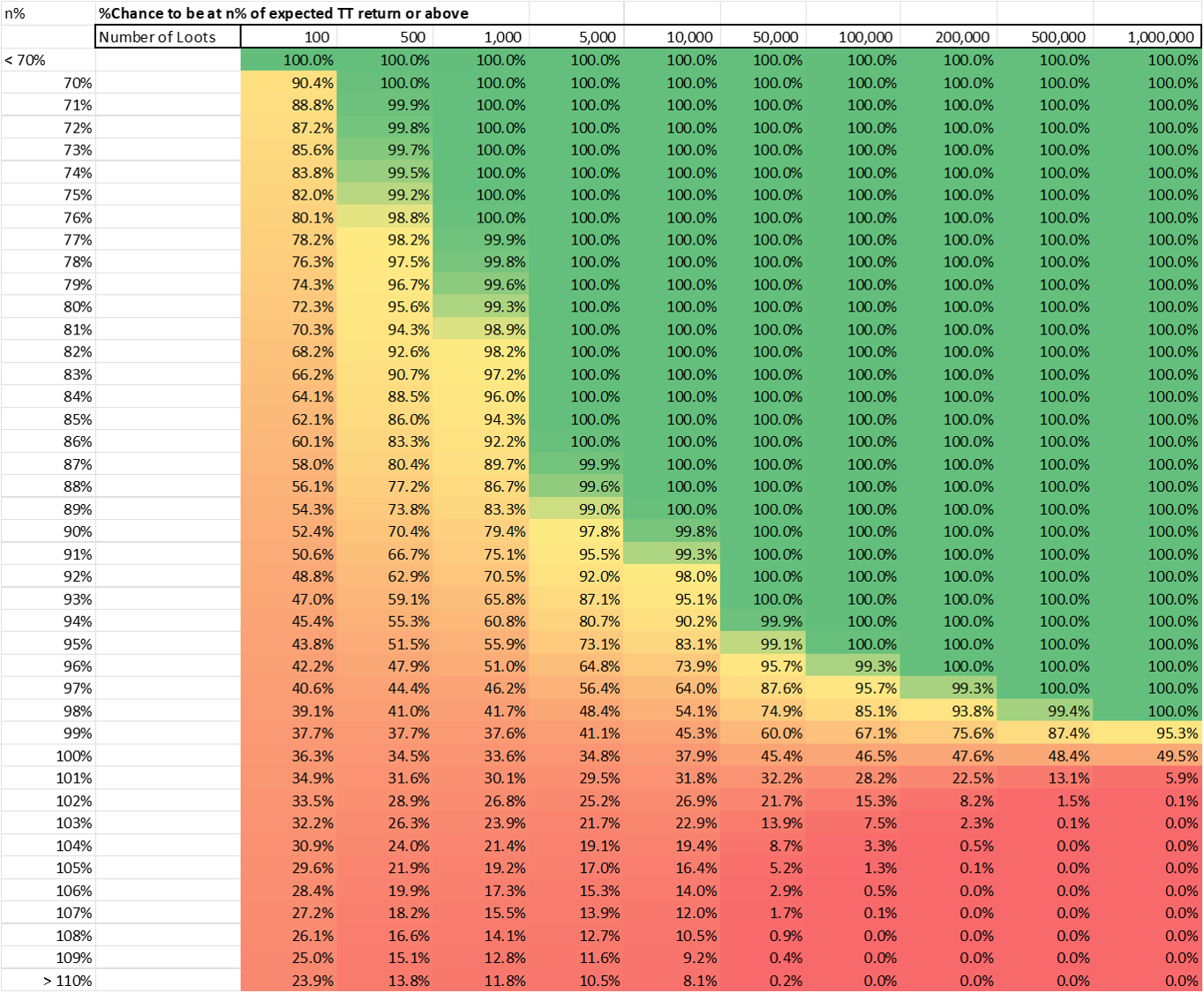Jhereg
Elite
- Joined
- Dec 13, 2005
- Posts
- 2,660
- Society
- Rangers
- Avatar Name
- Feng Huan SecretAznMan Zho
Hi everyone. After the many times I've seen the comment "Keep Shooting" or "I can't believe my returns are so bad" or "Look I have 100%+ TT return after 2000 kills so efficiency/looter doesn't matter and I hacked the system", I thought it was time to produce some quantitative data on evaluating your return % and, more importantly, how much confidence you can have that the TT% you have is near your expected value.
Many thanks to @miathan for access to his pytropia suite (https://github.com/opentropia/pytropia), along with his multiplier distribution data that he collected of a large number of loot samples. I was able to use his multiplier distribution, and run a large number of simulated hunts over different number of kills per hunt, to generate the table below.
One caveat: This distribution represents the generally most common loot distribution for mobs in game, but there is at least one other distribution for larger mobs, where the minimum multiplier is larger...so if you are using this on larger mobs, this may not be full reflective of the actual probabilities and will underestimate your chance to achieve expected %...
How to understand the table
Each column is hunts with a certain number of loot events (i.e. number of mobs killed). I've normalized a player's expected value, or EV (what their expected tt% will be after an infinite number of kills) to 100%. So whatever your expected loot return % should be (whether it is 90% or 99%), in this table, it is represented by 100%.
The leftmost column represents a threshold for observed return %, as a percentage of EV... This represents what percentage of your EV you want to achieve. The table shows the percent chance of achieving that performance or better.
As an example, if you want to know what the probability is of achieving 95% of your EV or better after 1000 kills, the table shows that you have a 56% chance of achieving that, versus after 10k kills, you would be at 83%. To flip that around, after 1000 kills, you have a almost 50/50 chance to be worse than 95% of your expected value versus better, while at 10000 kills, you have a 3 out of 20 chance of being worse than 95% of your expected value.
If you expect your long term expected tt% to be 98%, then you would have to multiply that 98% by the 95% here to get your real TT% threshold that you are evaluating for...
Hopefully this is useful, and again, thank you @miathan for all of your help and data gathering . He is the real MVP here.
. He is the real MVP here.
Updated with a couple more columns...

Many thanks to @miathan for access to his pytropia suite (https://github.com/opentropia/pytropia), along with his multiplier distribution data that he collected of a large number of loot samples. I was able to use his multiplier distribution, and run a large number of simulated hunts over different number of kills per hunt, to generate the table below.
One caveat: This distribution represents the generally most common loot distribution for mobs in game, but there is at least one other distribution for larger mobs, where the minimum multiplier is larger...so if you are using this on larger mobs, this may not be full reflective of the actual probabilities and will underestimate your chance to achieve expected %...
How to understand the table
Each column is hunts with a certain number of loot events (i.e. number of mobs killed). I've normalized a player's expected value, or EV (what their expected tt% will be after an infinite number of kills) to 100%. So whatever your expected loot return % should be (whether it is 90% or 99%), in this table, it is represented by 100%.
The leftmost column represents a threshold for observed return %, as a percentage of EV... This represents what percentage of your EV you want to achieve. The table shows the percent chance of achieving that performance or better.
As an example, if you want to know what the probability is of achieving 95% of your EV or better after 1000 kills, the table shows that you have a 56% chance of achieving that, versus after 10k kills, you would be at 83%. To flip that around, after 1000 kills, you have a almost 50/50 chance to be worse than 95% of your expected value versus better, while at 10000 kills, you have a 3 out of 20 chance of being worse than 95% of your expected value.
If you expect your long term expected tt% to be 98%, then you would have to multiply that 98% by the 95% here to get your real TT% threshold that you are evaluating for...
Hopefully this is useful, and again, thank you @miathan for all of your help and data gathering
Updated with a couple more columns...

Last edited:


